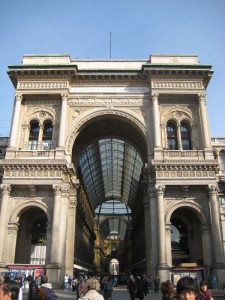
ECLA’s day-trip to Milan, part of the weeklong study trip to Italy, was an exciting adventure in the heart of the second largest city and largest metropolitan area in Italy, also known as the world capital of design and fashion. With the virtuoso guidance of ECLA Laura Scuriatti – a native Milanese – the city’s historical and architectural charm, as well as artistic treasures began to unfold in front of the eyes of ECLA students and faculty.
Our immersion in Milanese cultural heritage began at Piazza Duomo with a visit to the Milan Cathedral (Duomo di Milano), the biggest and greatest example of Gothic architecture in Italy and third largest in the world, after St. Peter’s Basilica in Rome and the Cathedral of Seville. Begun in 1386 with its façade started in 1567 and the front-works finished in 1805, the Duomo boasts a history that spans more than 4 centuries. Such a breathtaking setting provided not only for a discussion about the development of different architectural styles, but also for insightful reflection on the cathedral’s significance for Milan’s general history.
ECLA’s tour continued in Pinacoteca Ambrosiana, the oldest museum in Milan located at the premises of Biblioteca Ambrosiana, a historic library containing nearly 12,000 drawings by European artists from the 14th to the 19th century. The highlights included Leonardo da Vinci’s Atlantic Codex (Codex Atlanticus), a remarkable, twelve-volume, bound set of drawings and writings on subjects ranging from flight to weaponry and from musical instruments to mathematics and botany. The precious displays triggered an exuberant conversation about Leonardo’s diaries and drawings, which we had read closely as a part of the “Arts and Politics in Renaissance Florence” curriculum. Rafael’s gigantic preliminary drawing for the fresco “School of Athens,” itself located in the Vatican in Rome, was an equally captivating opportunity to scrutinize the painter’s technique and style.
ECLA students did not fail to try the local cuisine and joyfully compared the gourmet qualities of the renowned steak Milanesa (cotoletta alla Milanese) with the familiar German Schnitzel. Propelled by a round of powerful Italian espresso, the group continued with a tour of the picturesque Sforza Castle, named after the founder of the famous Sforza dynasty of Milan and reconstructed for museum purposes after severe damage during the allied bombardment of Milan in World War II. The Sforza Castle astonished us with an intricate ceiling decoration by Leonardo, representing a complex network of twigs and leaves growing from tree-trunks painted on the side walls in order to create the illusion of a forest beneath an open sky. Exuberant from the sight of this feast for the eye and imagination, we were not suspecting that more excitement was on the way: the Rondanini Pieta, Michelangelo’s last work situated in a neighboring room in the Sforza Castle, kept us breathless with its simultaneous tenderness and expressive power.
Our trip culminated with a visit to the refectory (dining hall) at Santa Maria delle Grazie, whose walls house one of the most celebrated masterpieces of Western art – Leonardo’s “Last Supper.” Having analyzed the grandiose fresco during an ECLA plenum session, we recollected the multitude of insightful interpretations we had become familiar with, while at the same time admiring the work’s unique aura.
The day finished with an exhilarating power-walk to the train-station, with laughter, enthusiasm and jubilation, and with recalling memorable phrases that would forever stay in the annals of AY 2009. Long after the Euro Star had taken us back to Florence, we kept on picturing in our minds the fascinating images of a Milan that had enchanted us with its unique spirit.
By Snezhina Kovacheva (2009, Bulgaria)
